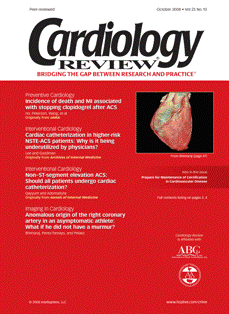Publication
Article
Cardiology Review® Online
High TIMI and GRACE risk scores in a postmenopausal woman
A postmenopausal woman 66 years of age presented to the emergency department with new-onset chest discomfort at rest.
A postmenopausal woman 66 years of age presented to the emergency department with new-onset chest discomfort at rest. The discomfort radiated to her jaw and neck, and was associated with nausea and diaphoresis. The initial episode of discomfort occurred at rest and resolved after 4 hours while she was at home, but recurred upon minor exertion. The discomfort increased in intensity and was persistent, prompting her to present to the local emergency department. While awaiting assessment, she was given nitroglycerin (Nitrostat) sublingually and the intensity of the discomfort lessened.
The patient’s medical history included hypertension and hyperlipidemia. Her medications included hydrochlorothiazide (Hydrodiuril) and pravastatin (Pravachol, Selektine), and she took vitamin E supplements. The patient had no known medication allergies. She acknowledged smoking approximately 1 pack of cigarettes daily, which she had done for the past 40 years. She denied excessive alcohol consumption or use of illicit drugs. Her family history was significant because her father died of a myocardial infarction at the age of 72.
On physical examination, the patient was not distressed. She weighed 145 lb, and her vital signs included a blood pressure of 170/92 mm Hg in both arms, a regular heart rate at 122 beats per minute, and an oxygen saturation of 97% on room air. A cardiovascular examination revealed no jugular venous distention and no carotid bruits. Chest auscultation revealed normal S1 and S2 heart sounds, an S4 heart sound, and normal breath sounds to the lung bases with no crackles. A 12-lead electrocardiogram revealed ST-segment depression of 1.0 mm to 1.5 mm in leads V3 to V6. Her initial creatine kinase, creatine kinase-muscle brain fraction, and cardiac troponin levels were not elevated. Serum creatinine was 1.2 mg/dL. A chest radiograph was normal.
The patient was admitted to the hospital for further management of her non—ST-segment elevation acute coronary syndrome. She was treated with aspirin, a beta blocker, and unfractionated heparin. Her thrombolysis in myocardial infarction (TIMI) risk score was calculated to be 5, and her Global Registry of Acute Coronary Events (GRACE) score was 144, which put her into an intermediate- to high-risk category for repeat myocardial infarction or death. The cardiology department was consulted to determine whether the patient should be referred for cardiac catheterization. Based on her initial high-risk presentation features, this patient was ultimately referred for cardiac catheterization.






